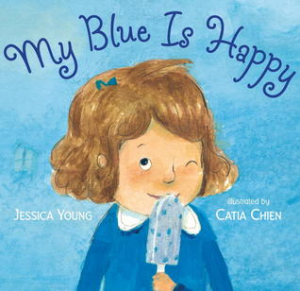 My Blue Is Happy
My Blue Is Happy
by Jessica Young
My Blue Is Happy is a young girl’s narrative as she explores the world of colour with family and friends and discovers the many emotions and possibilities that each colour evokes.
Strategies/Skills Used
Reading Strategy 2: Predict what will be learned or what will happen.
Reading Strategy 5: Make mental pictures.
Reading Strategy 6: Connect what you read with what you already know.
Reading Strategy 12: Reflect and respond.
Writing Skill 1: I generate ideas in a variety of ways.
Writing Skill 5: I carefully choose the most effective words to express my ideas.
Writing Skill 7: I use my personal style to make my writing unique.
 TEACHING THE ACTIVITY: PRE-READING
TEACHING THE ACTIVITY: PRE-READING
(1) Present both the cover image and the inside title page as the invitation into this selection. Ask for students’ thinking and predictions about the story.
(2) Appreciate the specialness of blue to the little girl in the images, and invite students’ interpretations and connections.
 TEACHING THE ACTIVITY: DURING READING
TEACHING THE ACTIVITY: DURING READING
(3) Present a window on your thinking as you read this book aloud. Point out that everyone feels differently about colours, and notice how the subject in the comparisons helps us make sense of the relationship between the colour and the feeling.
(4) Explore the idea of connecting something new to something we already know.
(5) Stop reading at any point when the students’ conversations about their own colour perceptions invite a writing connection.
 TEACHING THE ACTIVITY: POST-READING
TEACHING THE ACTIVITY: POST-READING
(6) Invite students to create their own quotation and image that interprets their colour/feeling connection, as per the author’s pattern.
(7) Make a class Little Feelings Book with the students’ completed works, titled for the colour that has been explored.
(8) Remember and revisit portions of My Blue Is Happy to recall colour referents for comparative connections in writing.
 TEACHING THE ACTIVITY: POST-READING EXTENSION
TEACHING THE ACTIVITY: POST-READING EXTENSION
(9) Introduce In My Heart/Dans mon petit coeur by Jo Witek with a similar lesson format, allowing the book cover to be the invitation, and the lyrical, but direct language of the child’s emotions to guide the read aloud. This is another book to visit and revisit in small portions to help students articulate emotions – each page focuses on one feeling and provides relatable similes, metaphors and symbols.
(10) Maintain ongoing discussions around the language of metaphor, where we invite personal connections and comparisons between one thing and another. This process will build students’ capacity for a thinking routine for synthesizing important ideas in content learning. (CSI: Colour, Symbol, Image, Making Thinking Visible, Ritchhart, Church, Morrison, 2011.)